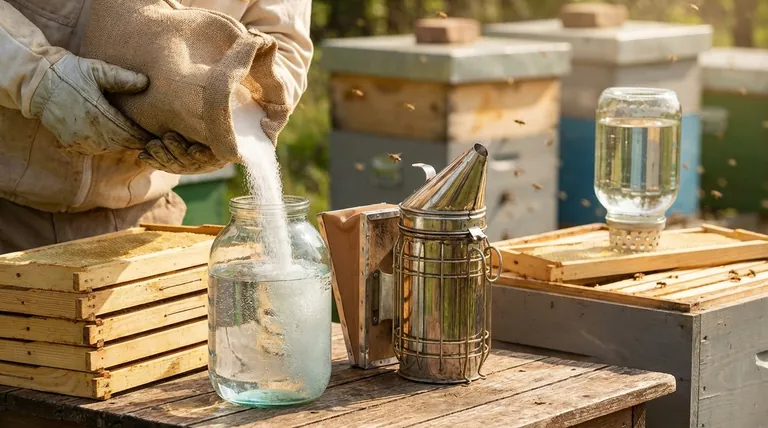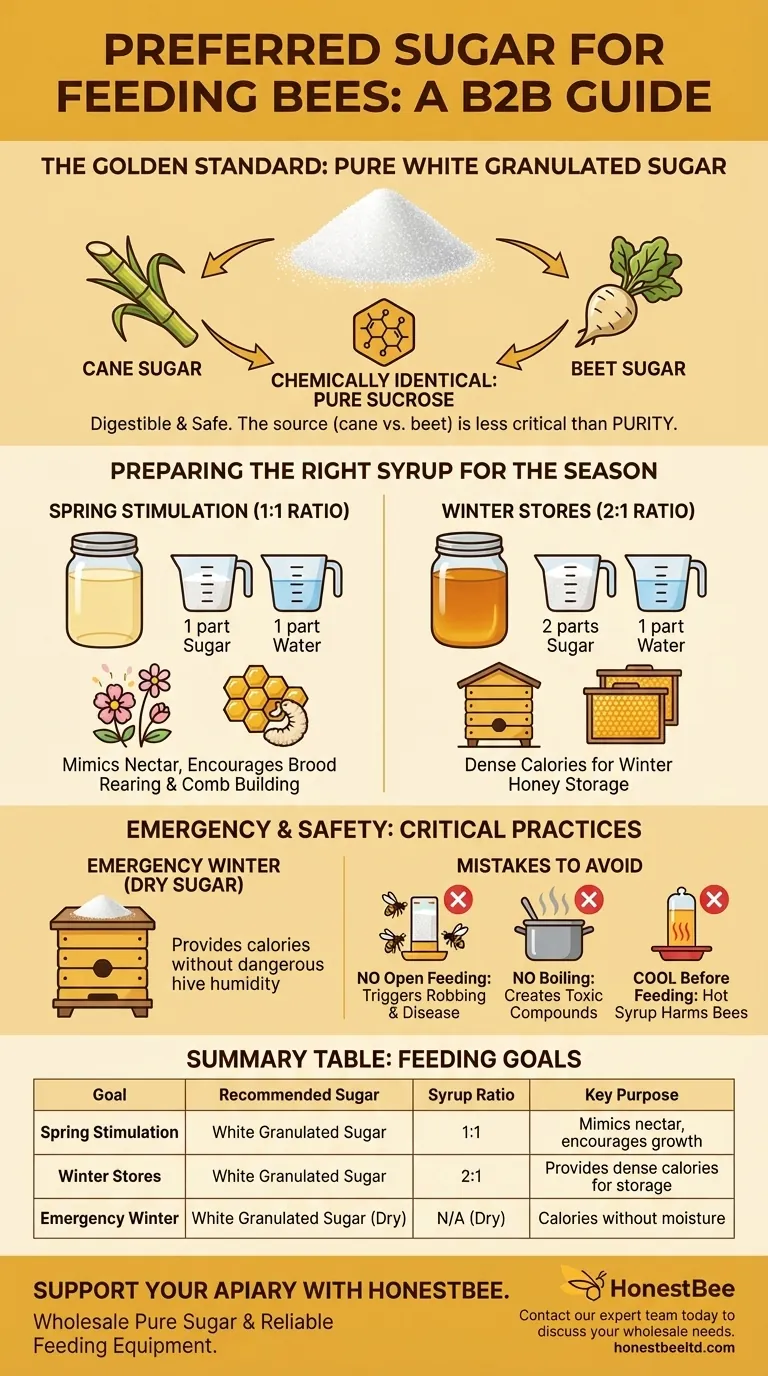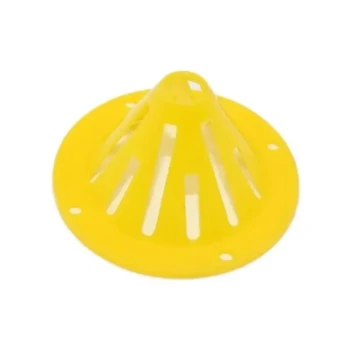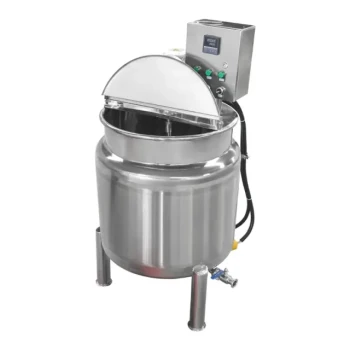The most preferred and safest sugar for feeding bees is plain white granulated sugar. This can be either cane sugar or beet sugar, as both are processed into pure sucrose, which is chemically identical and easily digestible for bees.
The debate between cane and beet sugar is a distraction from the real factors that ensure hive health. What truly matters is the purity of the sucrose, the correct sugar-to-water ratio for the season, and safe feeding practices that prevent disease and robbing.

The Great Debate: Cane vs. Beet Sugar
Many beekeepers have a strong preference for one type of sugar, but the science indicates the source is less important than the final product.
### Why Purity is the Only Thing That Matters
Both cane sugar and beet sugar, once refined into the white crystals you buy in a store, are chemically sucrose. Bees' digestive systems are perfectly equipped to break down sucrose into glucose and fructose.
From a bee's perspective, pure sucrose from a beet is indistinguishable from pure sucrose from a sugarcane plant.
### The GMO Concern
The primary objection to beet sugar is that most of it is derived from genetically modified plants. However, the refining process removes all proteins and DNA.
Laboratory tests have found no difference in bee health or preference when consuming sugar from GMO versus non-GMO sources. Many successful beekeepers use beet sugar without any issues.
Preparing the Right Syrup for the Season
The concentration of your sugar syrup should change based on your colony's needs and the time of year.
### The 1:1 Ratio for Stimulation
A 1:1 mixture of sugar to water (by weight) mimics the consistency of natural nectar. This ratio is typically used in the spring to stimulate brood rearing and encourage comb building.
### The 2:1 Ratio for Winter Stores
A 2:1 mixture of sugar to water is much thicker and is used in the fall. The goal of this heavier syrup is to provide dense calories that the bees can easily store as honey for the winter.
### Dry Sugar Feeding
In winter, adding moisture to the hive can be dangerous. Some beekeepers use specially formulated raw sugars, like Divert sugar, or plain granulated sugar in a dry form to provide emergency food without increasing hive humidity.
Critical Mistakes to Avoid When Feeding
How you feed your bees is just as important as what you feed them. Poor practices can do more harm than good.
### Never Feed in the Open
Leaving sugar syrup or dry sugar outside is a critical error. It attracts bees from neighboring hives and feral colonies, which wastes resources.
More importantly, it can trigger a "robbing" frenzy, where stronger colonies attack weaker ones, and it is a primary vector for spreading bee diseases throughout your apiary.
### The Danger of Overheating
To prepare syrup, heat the water, but remove it from the heat source before adding the sugar. Stir until it is completely dissolved.
Never boil the sugar and water together. Boiling can cause the sugar to caramelize, which creates compounds that are toxic to bees.
### Always Cool the Syrup
Syrup must be cooled to room temperature before being placed in a feeder. Hot syrup can seriously harm or kill the bees that come to consume it.
Making the Right Choice for Your Goal
Your feeding strategy should be a direct response to what your colony needs to thrive.
- If your primary focus is stimulating spring growth: Use a 1:1 syrup made from plain white sugar to encourage population buildup.
- If your primary focus is building winter stores: Use a thick 2:1 syrup in the fall to help your bees pack away sufficient food.
- If your primary focus is emergency winter feeding: Apply dry sugar to provide calories without adding harmful moisture to the hive.
Ultimately, providing pure sugar in the right concentration and with safe methods is the key to successfully supporting your bees.
Summary Table:
| Feeding Goal | Recommended Sugar | Syrup Ratio | Key Purpose |
|---|---|---|---|
| Spring Stimulation | White Granulated Sugar | 1:1 (Sugar:Water) | Mimics nectar, encourages brood rearing & comb building. |
| Winter Stores | White Granulated Sugar | 2:1 (Sugar:Water) | Provides dense calories for bees to store as winter honey. |
| Emergency Winter Feeding | White Granulated Sugar (Dry) | N/A (Dry) | Provides calories without adding dangerous hive humidity. |
Ready to support your apiary with the right supplies?
As a leading wholesale supplier to commercial apiaries and beekeeping equipment distributors, HONESTBEE provides the high-quality, pure sugar and reliable feeding equipment you need to maintain healthy, productive hives. Let us help you streamline your operations with our bulk-focused solutions.
Contact our expert team today to discuss your wholesale needs and ensure your bees get the best nutrition.
Visual Guide

Related Products
- Stainless Steel Honey Bee Smoker Hive and Honeycomb Smoker for Beekeeping
- Premium Traditional Copper Bee Smoker with Bellows
- High Performance Plastic Queen Excluder for Beekeeping and Apiary Management
- Professional Spring-Action Queen Catcher Clip
- Economy Small Scale Honey Dryer Dehumidifier Thickening Machine
People Also Ask
- What is the primary purpose of using smoke in beekeeping? Calm Bees for Safer Hive Management
- How did early beekeepers use bee smokers? Master Ancient Bee Calming Techniques
- What happens to bees when they sense smoke? Unlock the Secret to Calm Hive Inspections
- What is the proper technique for lighting a bee smoker? Master the Layered Fire Method for Calm Hives
- What is a Smoker and how is it used in beekeeping? The Essential Tool for Calm, Safe Hive Inspections



















